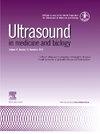基于梯度光流的超声斑点追踪法量化外周神经的微小纵向位移、剪切和纵向应变
IF 2.4
3区 医学
Q2 ACOUSTICS
引用次数: 0
摘要
研究目的本研究旨在开发、验证和测试基于梯度光流的超声(US)斑点追踪方法在量化周围神经的微小纵向位移、剪切力和应变方面的临床可行性:方法:使用七只解冻、新鲜冷冻的离体尸体前臂对斑点追踪法进行了验证。使用 22 MHz 高频线性探针捕捉正中神经的纵向运动。插入一个气泡标记作为参考点,进行人工测量比较。通过比较手动和自动测量,评估了该方法的精确度和准确性。对 8 名健康受试者进行了临床可行性测试,测量肘关节伸展和肩关节前屈时正中神经的纵向位移:结果:该方法表现出线性、高精度和准确性,尤其是在回溯五帧的情况下,可将位移低估率降至 4%。在尸体模型中,神经组织界面处的剪切应变最大。在健康受试者中,正中神经的平均位移为 3.3 ± 1.0 毫米,评分者之间的可靠性良好(类内相关系数 = 0.87):结论:基于梯度光流的 US斑点追踪法能有效量化周围神经的微小纵向位移和剪切应变,具有较高的精确度和准确性。然而,该方法无法检测到测试位移范围内的神经纵向应变。未来的研究应探讨该方法是否适用于较小和较深的神经,以及在不同病理条件下的实用性。本文章由计算机程序翻译,如有差异,请以英文原文为准。
Ultrasound Speckle Tracking Method Based on Gradient Optical Flow to Quantify Small Longitudinal Displacement, Shear and Longitudinal Strain in Peripheral Nerves
Objective
This study aimed to develop, validate and test the clinical feasibility of ultrasound (US) speckle tracking method based on gradient optical flow for quantifying small longitudinal displacements, shear and strain in peripheral nerves.
Methods
The speckle tracking method was validated using seven thawed, fresh-frozen isolated cadaveric forearms. Longitudinal motion of the median nerve was captured using a high-frequency 22 MHz linear probe. An air bubble marker was inserted as a reference point for manual measurement comparison. The precision and accuracy of the method were assessed by comparing manual and automatic measurements. Clinical feasibility was tested on eight healthy subjects, measuring the longitudinal displacement of the median nerve during elbow extension and shoulder anteflexion.
Results
The method demonstrated linearity, high precision and accuracy, particularly with a backtrace of five frames, reducing the displacement underestimation to 4%. In cadaveric models, the highest shear strain was observed at the nerve-tissue interfaces. In healthy subjects, the mean displacement of the median nerve was 3.3 ± 1.0 mm, with good inter-rater reliability (intraclass correlation coefficient = 0.87).
Conclusion
The US speckle tracking method based on gradient optical flow effectively quantifies small longitudinal displacements and shear strain in peripheral nerves, with high precision and accuracy. However, the method could not detect longitudinal strain in nerves within the range of tested displacements. Future studies should investigate its applicability to smaller and deeper nerves and its usefulness in different pathological conditions.
求助全文
通过发布文献求助,成功后即可免费获取论文全文。
去求助
来源期刊
CiteScore
6.20
自引率
6.90%
发文量
325
审稿时长
70 days
期刊介绍:
Ultrasound in Medicine and Biology is the official journal of the World Federation for Ultrasound in Medicine and Biology. The journal publishes original contributions that demonstrate a novel application of an existing ultrasound technology in clinical diagnostic, interventional and therapeutic applications, new and improved clinical techniques, the physics, engineering and technology of ultrasound in medicine and biology, and the interactions between ultrasound and biological systems, including bioeffects. Papers that simply utilize standard diagnostic ultrasound as a measuring tool will be considered out of scope. Extended critical reviews of subjects of contemporary interest in the field are also published, in addition to occasional editorial articles, clinical and technical notes, book reviews, letters to the editor and a calendar of forthcoming meetings. It is the aim of the journal fully to meet the information and publication requirements of the clinicians, scientists, engineers and other professionals who constitute the biomedical ultrasonic community.

 求助内容:
求助内容: 应助结果提醒方式:
应助结果提醒方式:


